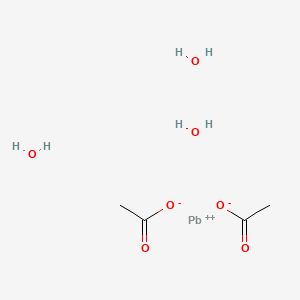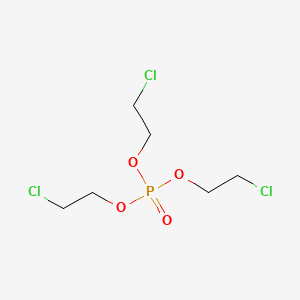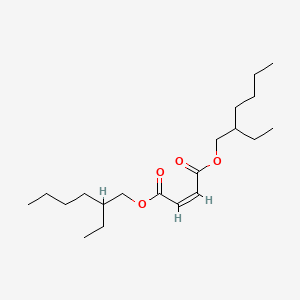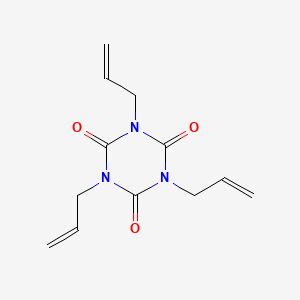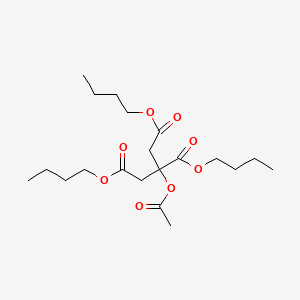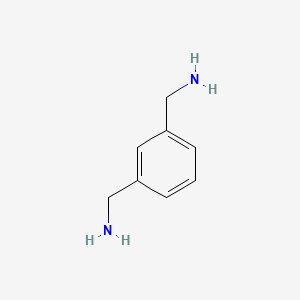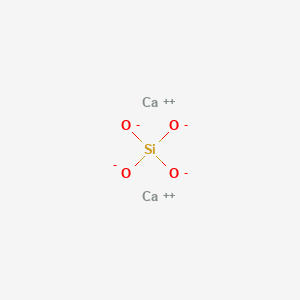Lead Acetate Trihydrate CAS 6080-56-4

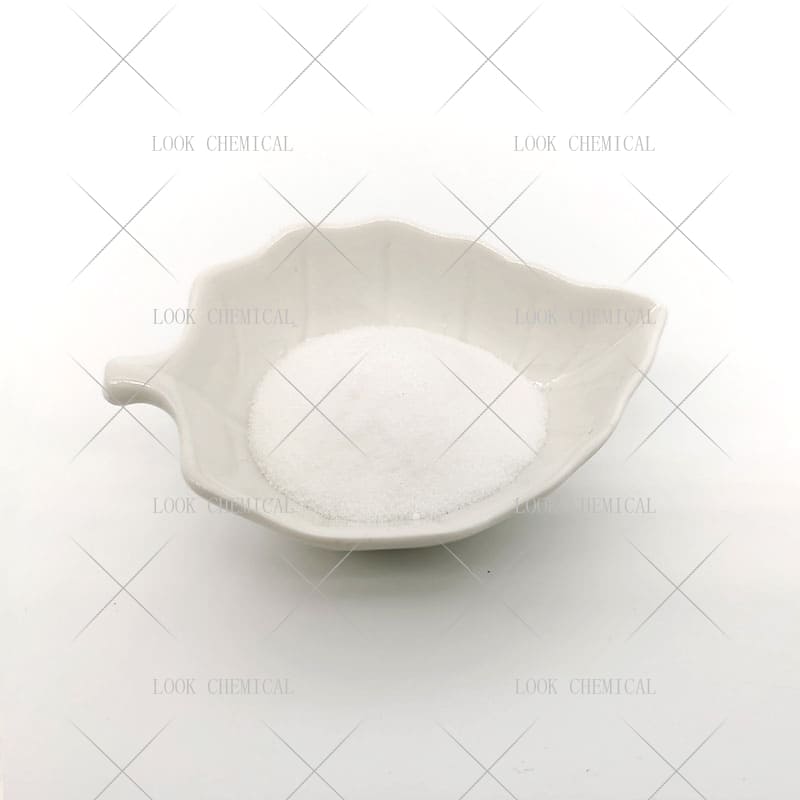
Free Sample Trimethylolpropane CAS 77-99-6
- Appearance:Powder
- Purity:99.8%
- Delivery:30days
- Sample Available:Available
- Payment:L/C,T/T,D/P,Paypal,Money Gram,Western Union
- Incoterm: FOB,CFR,CIF,EXW,FCA,CPT,CIP
- Transporta:Ocean, Land,Air, DHL,TNT FedEx
Name: Lead Acetate Trihydrate
CAS: 6080-56-4
MOQ: 1KG
Directory Guidance on Lead Acetate Trihydrate
Chemical Structure
Basic Info:
| Melting point | 75 °C (dec.)(lit.) |
| Boiling point | 280°C |
| density | 2,55 g/cm3 |
| bulk density | 1200kg/m3 |
| storage temp. | 2-8°C |
Product Introduction:
Lead Acetate Trihydrate, with the chemical formula Pb(CH₃COO)₂·3H₂O, is a lead-containing organometallic compound that usually exists in colorless or white crystalline form at room temperature. Its crystal structure contains three crystal water molecules, which makes Lead Acetate Trihydrate easy to absorb moisture in the air and gradually lose some crystal water to form intermediate products with different hydration degrees. The density of this compound at room temperature is about 2.55 g/cm³, and the melting point is about 75°C, but it will decompose to form lead oxide and other organic by-products at higher temperatures. Its molecular weight is 379.33 g/mol, and it is soluble in water and some polar organic solvents, but almost insoluble in non-polar solvents.
From the perspective of chemical properties, Lead Acetate Trihydrate exhibits typical lead salt characteristics, such as reacting with sulfide to form black lead sulfide precipitate, and reacting with iodide to form yellow lead iodide precipitate. In addition, its aqueous solution is weakly acidic, which is caused by the hydrolysis of acetate ions and the weak acidity of lead ions. It is worth noting that the presence of lead ions (Pb²⁺) makes it significantly toxic, and long-term contact or ingestion may lead to lead poisoning, so safety operating specifications must be strictly followed in practical applications.
In industrial production, Lead Acetate Trihydrate is usually prepared by reacting metallic lead or lead oxide with acetic acid. The specific process includes slowly adding lead or lead oxide powder to a heated acetic acid solution, and finally crystallizing to obtain the target product by controlling the reaction temperature and stirring speed. Due to the toxicity of lead, the entire production process must be carried out in a closed environment and equipped with a complete waste gas and waste liquid treatment system to reduce harm to the environment and operators.
As a common laboratory reagent, Lead Acetate Trihydrate is often used for precipitation reactions in analytical chemistry,Its high-purity product can also be used as a catalyst or precursor for certain organic synthesis reactions. However, its chemical stability is relatively limited, and high temperature, humidity or light conditions must be avoided during long-term storage, otherwise decomposition or deliquescence may occur. In addition, due to the environmental accumulation of lead ions, waste disposal must comply with environmental regulations. Chemical precipitation is usually used to convert lead into insoluble sulfides or carbonates before landfill.
Nature and Specifications:
| Item | Specification |
| Product Name | Lead Acetate Trihydrate |
| CAS No. | 6080-56-4 |
| Appearance | Powder |
| Shelf Life | 2 years |
| Packing | As your requirements |
| solubility | 443g/l |
| form | Solid |
| color | White or colorless, efflorescent |
| Specific Gravity | 2.55 |
| PH | 5.5-6.5 (50g/l, H2O, 20℃) |
| Water Solubility | 625 g/L |
Product service:
- Certificate Of Analysis (COA)
- Material Safety Data Sheet (MSDS)
- Route of synthesis (ROS)
- Method of Aanlysis (MOA)
- Nuclear Magnetic Resonance (NMR)
- Packing pictures and loading video before loading
- Free Sample
- Factory audit
In the industrial field, Lead Acetate Trihydrate is mainly used in electroplating, battery manufacturing and pigment production. For example, in the plate treatment process of lead-acid batteries, its solution can be used to form a uniform lead oxide coating, thereby improving the battery’s charge and discharge efficiency. In addition, in the synthesis of certain special pigments (such as chrome yellow), Lead Acetate Trihydrate can be used as a lead source to participate in the reaction, and the hue and hiding power of the pigment can be controlled by adjusting the reaction conditions. In the textile industry, it is occasionally used as a mordant to help dyes bind to fibers, but such applications have gradually decreased due to environmental restrictions.
In laboratory scenarios, this compound is an important analytical reagent. For example, in environmental monitoring, its solution can be used to detect the sulfide content in water samples: sulfur ions combine with lead ions to form black lead sulfide precipitates, and the sulfide concentration is determined by turbidimetry or gravimetry. In the field of organic synthesis, Lead Acetate Trihydrate can be used as an oxidant or Lewis acid catalyst to participate in certain condensation reactions or deprotection reactions. In addition, in materials science, its thermal decomposition properties are used to prepare nano-lead oxide materials, which have potential value in the fields of sensors or photocatalysis.
In recent years, with the tightening of environmental regulations, the traditional application of Lead Acetate Trihydrate has been restricted to a certain extent, but its new uses in the field of high technology have gradually emerged. For example, in the study of perovskite solar cells, it is used as a lead source to prepare the precursor solution of the light absorption layer; in the nuclear industry, lead compounds are used in the development of radiation shielding materials. Although these emerging applications have not yet been commercialized on a large scale, their technical potential is worthy of attention.
It should be emphasized that due to the toxicity of lead, the use of Lead Acetate Trihydrate must strictly follow safety regulations. In industrial production, operators need to wear protective equipment and lead concentration monitoring devices need to be installed in the workplace. When used in the laboratory, it is recommended to operate in a fume hood to avoid direct contact with the skin or inhalation of dust. The treatment of waste requires chemical fixation, such as adding sodium sulfide solution to convert lead ions into lead sulfide precipitation, and then handing it over to professional institutions for disposal.
From the perspective of the global market, the main producers of Lead Acetate Trihydrate include China, India and some European countries. With the advancement of industrialization in emerging economies, its demand remains stable in specific areas, but the overall market growth is limited by environmental protection policies. In the future, developing low-toxic alternatives or efficient recycling technologies will become a key direction for the development of the industry. At present, some studies have tried to partially replace the function of lead salts with metal salts such as bismuth and tin, but there is still a gap in performance.
Lead Acetate Trihydrate has certain competitive advantages in the market. First, its purity is high. The purity of general industrial products can reach more than 98%. After further purification, higher purity products can be obtained, which provides a guarantee for its application in high-precision chemical synthesis, analytical testing and other fields. High-purity products can reduce the interference of impurities, improve the selectivity of the reaction and the purity of the product, and meet some process requirements that have strict requirements on the purity of raw materials.
Secondly, Lead Acetate Trihydrate has relatively good stability. At room temperature and pressure, it can maintain a relatively stable state and is not easy to decompose or deteriorate, which makes it more convenient during storage and transportation, and no special conditions are required to maintain its properties. Appropriate reaction conditions and processes can be selected according to specific needs to achieve diversified product synthesis and application.
Furthermore, Lead Acetate Trihydrate has good solubility and is easily soluble in water, which makes its application in aqueous solution convenient, can quickly disperse and participate in the reaction, and improve reaction efficiency and production efficiency. This good solubility facilitates its application in some chemical reactions, dyeing processes or analytical tests that require an aqueous solution system, helping to achieve a uniform reaction environment and accurate reaction control.
Contact Us
Product Package picture:


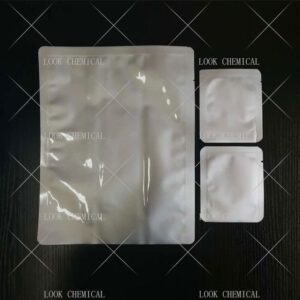
Related References:
chemicalbook-Lead Acetate Trihydrate
Lead Acetate Trihydrate Manufacturer
Contact Us
As an experienced Lead Acetate Trihydrate manufacturer and supplier, Look Chemical is committed to producing and selling high quality products.
We cooperate and trade with 6000+ factories around the world, and our high-quality products and excellent services make us enjoy a high reputation internationally.
As Lead Acetate Trihydrate CAS 6080-56-4 supplier, Look Chemical provides supply chain solutions to partners and customers in a wide range of industries. We offer competitive pricing and quality products.
If you have a demand for this product, please contact our company’s sales staff, we will provide you with a solution in the shortest time.
Transport proposal

1. For products ≤50kg, we recommend using express delivery, which is usually called DDU service (discounted, convenient).
2. For products ≤500kg, we generally recommend air freight, which is usually called FOB, CFR or CIF service (fast and efficient).
3. For products >500kg, we generally recommend shipping by sea, which is usually called FOB, CFR or CIF service (economical, safe).
4. For high-value products, please choose air or express to ensure the safety of product transportation.
Shandong Lookchemical service:
* Timely reply and 24 hours online, the professional team will provide you with the most favorable prices and high-quality products.
* The sample supports testing and inspection.
* Each batch of products will be tested to ensure that its quality meets user needs.
*Packaging can also be made according to customer requirements.
*Any inquiries will be answered by our relevant personnel within 24 hours.
*We will provide you with commercial invoice, packing list, packing list, COA, health certificate and certificate of origin if you need it. If your market has other special requirements, please let us know.
*We will monitor the logistics information in real time and will share the information with you.
* You can consult us at any time if you have any questions about the product, and we will answer you in time.
*If you have any questions about the product, you can report it to us, we will deal with it in time for you, and the product can be returned.
Contact Us
Frequently Asked Questions(FAQ):
We will make samples before mass production, and after sample approved, we’ll begin mass production. Doing 100% inspection during production, then do random inspection before packing.
Our MOQ is 1kg. But usually we accept less quantity such as 100g on the condition that sample charge is 100% paid.
Yes. We’ll give you product analysis report before shipping.
Different quantity has different discount.
Yes. Welcome to visit.
You can get free samples for some products,you only need to pay the shipping cost or arrange a courier to us and take the samples. You can send us your product specifications and requests,we will manufacture the products according to your requests.

